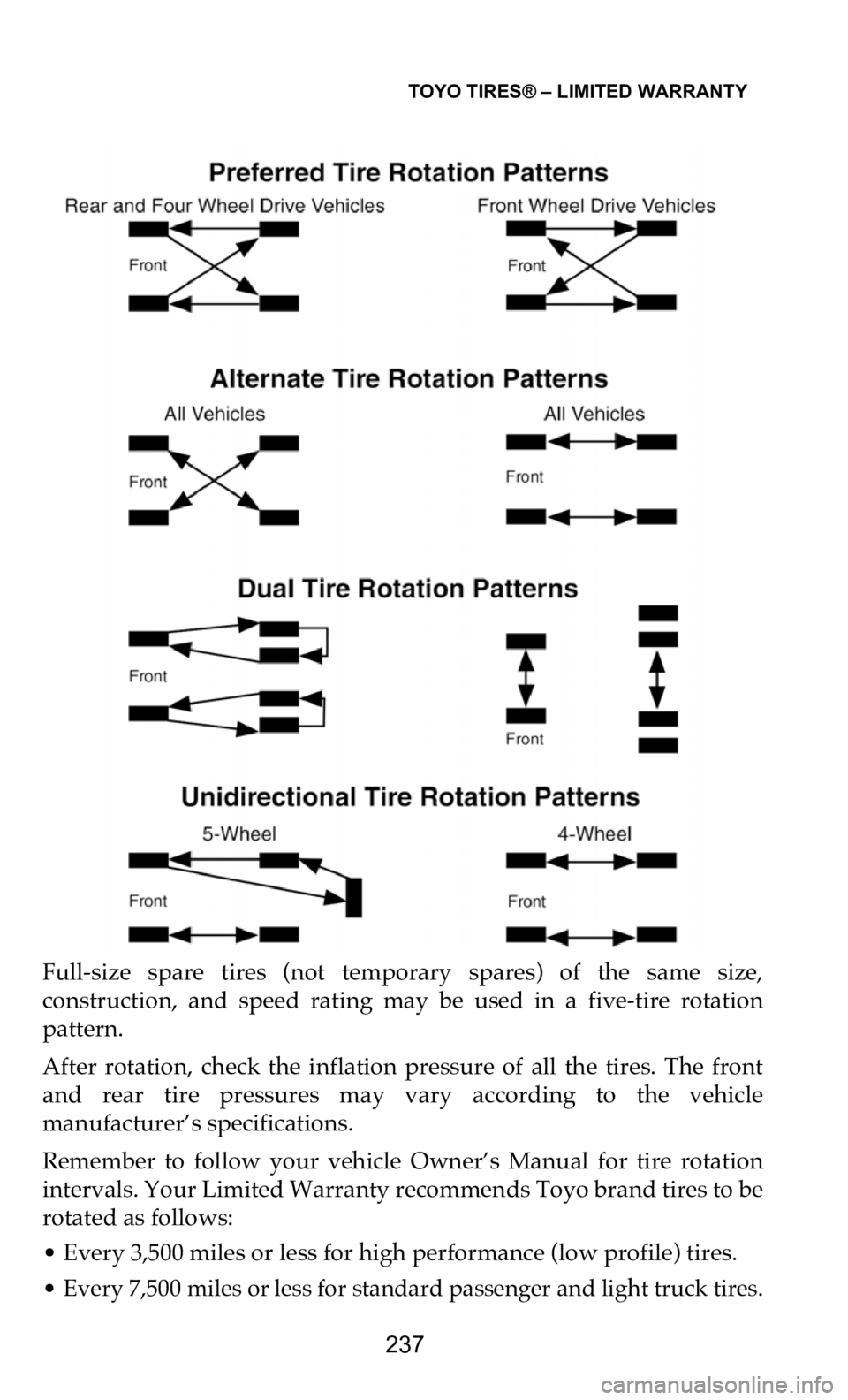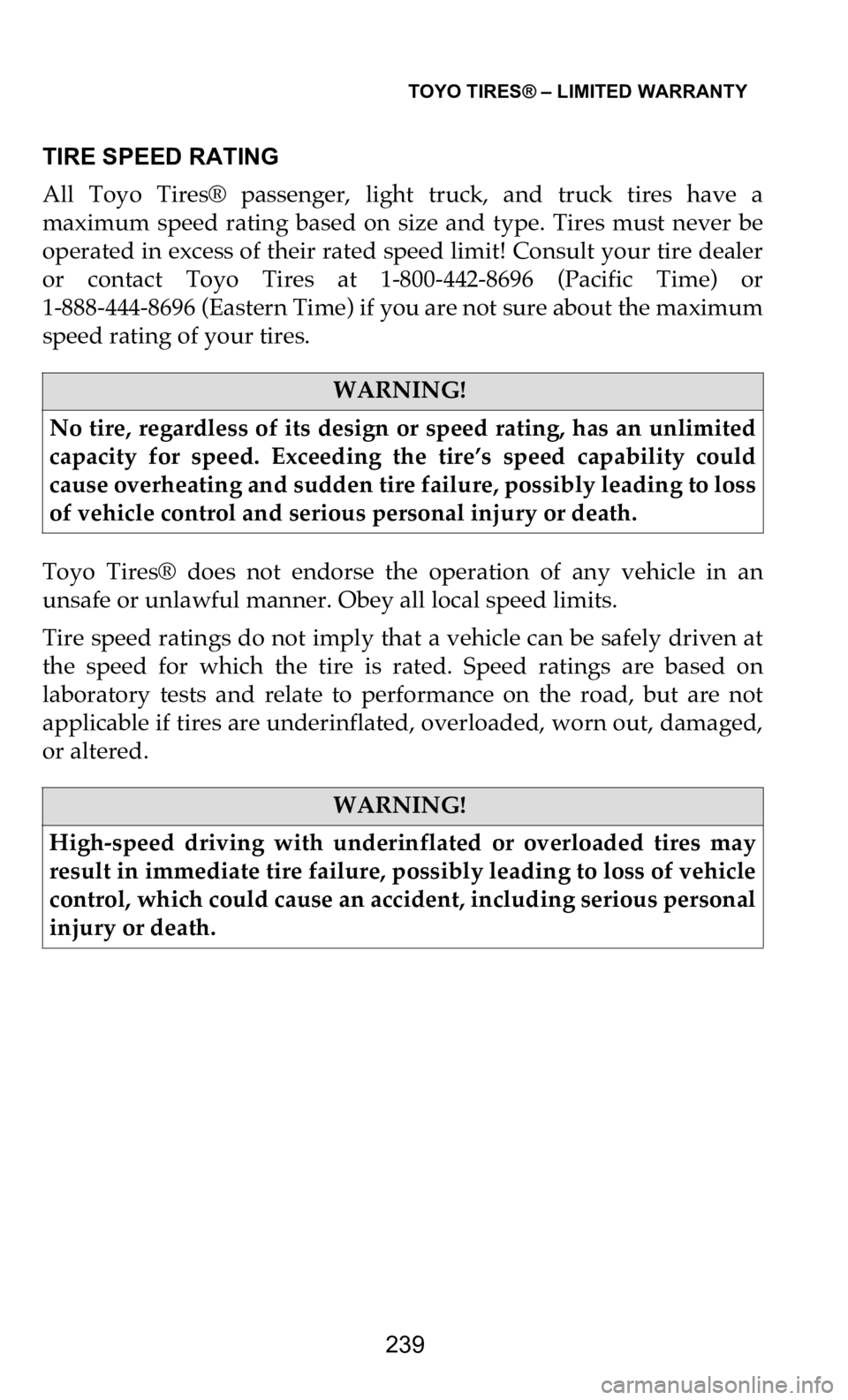DODGE DURANGO 2021 Vehicle Warranty
Manufacturer: DODGE, Model Year: 2021, Model line: DURANGO, Model: DODGE DURANGO 2021Pages: 262, PDF Size: 10.42 MB
Page 231 of 262

TOYO TIRES® – LIMITED WARRANTY
230
(Continued)
CONSIDERATIONS IN PLUS SIZING
Always refer to and follow the vehicle manufacturer’s replacement
ti
re recommendations. In some cases, a vehicle manufacturer may
specifically advise against the application of replacement tires that are
not of the original size or type.
TIRE AND WHEEL MATCHING AND MOUNTING
WARNING!
Any attempt to mount a tire on a wheel with a different diameter
wi
ll result in an explosion of the tire/wheel assembly that could
cause severe personal injury or death.
Prior to mounting any tire, always check the wheel identification
st
amp to verify the correct wheel diameter. Always check the tire
size molded onto the sidewall.
Never exceed 40 psi when seating the tire beads onto the wheel.
Always stand well clear of any tire mounting operation. This is
es
pecially important when the service operator inflates the tire. If
the tire has been improperly mounted, it could burst with
explosive force causing serious personal injury or death.
A new valve stem must be installed on the wheel each time a
wo
rn out passenger or light truck tire is replaced.
Removing and replacing tires on wheels can be dangerous.
Attempting to mount tires with improper tools or procedures
co
uld result in a tire explosion, causing serious personal injury or
death. This is a job for your authorized Toyo Tires dealer or other
qualified tire service location only.
Serious personal injury or death can result from:
• Failure to select the proper tire and wheel. The tire must match
t
he width and diameter requirements of the wheel. When
mounting truck type radial tires use only wheels approved for
radial tires.
• Failure to inspect both the tire and wheel. The wheel must be
f
ree of cracks, dents, chips, and rust. The tire must be free of bead
damage, cuts, and punctures.
Page 232 of 262

TOYO TIRES® – LIMITED WARRANTY
231
TIRE MIXING
• Toyo Tires® recommends that all four tires be of the same size,
s
peed rating, and construction (radial or non-radial). In some cases
the vehicle manufacturer may require different sized tires for the
front or rear axles. Never mix P-metric or European Metric
passenger tires with LT-metric tires on the same vehicle.
• Match tire size designations in pairs on an axle, except during the
t
emporary use of a spare tire.
• If two radial tires and two non-radial tires are used on a vehicle, put
t
he radials on the rear axle. If radial and non-radial tires are used on
a vehicle equipped with dual rear tires, the radial tires may be used
on either axle.
SPEED-RATED TIRE
• If the vehicle Tire Information Placard and/or the vehicle Owner’s
M
anual specifies speed-rated tires, the replacement tires must have
the same or higher speed rating to maintain vehicle speed capa -
bility.
• F
ailure to follow proper procedures. For proper mounting proce -
d
ures, consult the Rubber Manufacturers Association’s publica -
tion “Care and Service of Automobile and Light Truck Tires”
(r
ef.: www.ustires.org ).
•
Exceeding the maximum bead seating pressure of 40 psi. Be
a
bsolutely certain beads are fully seated before adjusting the
inflation pressure to the level recommended for vehicle opera -
tion.
Never put flammable substances in the tire/wheel assemblies at
an
y time. Never put any flammable substance into a tire/wheel
assembly and attempt to ignite it in order to seat the beads.
CAUTION!
Driving your vehicle with an improper mix of tire sizes,
co
nstructions, and speed ratings can be dangerous. Your car’s
handling characteristics can be adversely affected. You could have
an accident resulting in serious personal injury or death. Consult
your vehicle Owner’s Manual or an authorized Toyo Tires dealer
for proper tire replacement.
WARNING! (Continued)
Page 233 of 262

TOYO TIRES® – LIMITED WARRANTY
232
• If a replacement tire has a lower speed capability than that specified
by the vehicle manufacturer, the vehicle’s speed must be restricted
to that of the replacement tire. Vehicle handling could also be
affected. Consult the vehicle Owner’s Manual or tire manufacturer
for recommendations.
• If tires with different speed ratings are used, it is recommended that
t
he lower speed- rated tires always be placed on the front axle. This
is to prevent a potential oversteer condition.
FOUR-WHEEL DRIVE (4WD) AND ALL-WHEEL DRIVE (AWD)
VE
HICLES
If no instructions for tire mixing appear in the vehicle Owner’s
Ma
nual, follow these guidelines:
• Do not mix tire sizes. All four tires must be marked with the same
t
ire size, unless otherwise specified by the vehicle manufacturer.
This also applies to winter/snow tires.
• Do not mix tread pattern types such as all-terrain and all- season.
S
TUDLESS WINTER/SNOW TIRES
• It is always preferable to apply winter/snow tires to all wheel posi -
t
ions, including dual tires, to maintain vehicle mobility and control.
• If winter/snow tires are applied to the f
ront axle of any vehicle,
winter/snow tires must also be installed on the
rear axle. DO NOT
apply winter/snow tires only to the front axle. This applies to all
passenger and light truck vehicles, including front-wheel- drive,
4WD, and AWD vehicles.
• If winter/snow tires are installed on the rear axle of any vehicle, it is
recommended (but not required) that they also be installed on the
front axle.
WARNING!
Unless winter/snow tires on the rear axle have comparable
tr
action qualities to the tires on the front axle, the vehicle may
experience adverse handling characteristics. This may result in
loss of vehicle control, which can lead to serious personal injury
or death.
Page 234 of 262

TOYO TIRES® – LIMITED WARRANTY
233
STUDDED WINTER/SNOW TIRES
• Studded winter/snow tires have higher traction qualities under
m
ost winter weather conditions.
• If studded winter/snow tires are installed on the f
ront axle of any
vehicle, studded winter/snow tires must also be installed on the
rear axle. DO NOT apply studded winter/snow tires only to the
front axle.
• If studded winter/snow tires are installed on the rear axle of any
vehicle, it is strongly recommended that they should also be
installed on the
front axle. Only if studded winter/snow tires are
installed on all wheel positions of a vehicle will optimum handling
characteristics be achieved.
REPLACING TWO TIRES
• When a pair of replacement tires is selected in the same size and
c
onstruction as those on the vehicle, the two newer tires must be
installed on the rear axle and must be of equal or higher speed rating
than the front tires. Generally, new tires with deeper tread will
provide better grip and evacuate water more effectively, which is
important as a driver approaches hydroplaning situations. Placing
greater traction on the rear axle on wet surfaces is necessary to
prevent a possible oversteer condition and loss of vehicle stability.
WARNING!
Installing only two studded winter/snow tires on the front axle of
an
y vehicle (including front-wheel-drive vehicles) without
studded winter/snow tires on the rear axle can cause adverse
vehicle handling characteristics. This can result in a loss of
vehicle control, which could cause serious personal injury or
death.
CAUTION!
In some cases, the vehicle manufacturer may specifically advise
ag
ainst replacing fewer than all four tires. Always check and
follow the recommendations in the vehicle Owner’s Manual. For
4WD and AWD vehicles, even small differences in outside
diameter may cause drivetrain damage or mechanical
malfunction.
Page 235 of 262

TOYO TIRES® – LIMITED WARRANTY
234
• When two new tires have been installed onto the rear axle positions,
they are to be kept on the rear but rotated from side to side. This is
recommended after installing two new tires to the rear position, or
if you discover significant tread depth differences between the front
and rear positions during rotation intervals.
REPLACING ONE TIRE
• Replacing a single tire on a vehicle can have an adverse effect on
s
uspension systems, gear ratios, transmission, and tire treadwear.
• If single tire replacement is unavoidable, it is recommended that the
s
ingle new tire be paired with the tire that has the deepest tread and
both be placed on the rear axle. Placing greater traction on the rear
axle on wet surfaces is necessary to prevent a possible oversteer
condition and loss of vehicle stability.
WHEEL ALIGNMENT AND BALANCING
• Proper wheel alignment and balance are very important consider -
a
tions for safety and getting the maximum mileage from your tires.
Yo
u need to check how your tires are wearing at least once a month.
• Your vehicle may be out of alignment if your tires are wearing
u
nevenly, such as when the inside shoulder of the tire is wearing
faster than the rest of the tread. This condition not only shortens the
life of your tires, it adversely affects the handling characteristics of
your vehicle, which could be dangerous. If your tires show irregular
wear, have your vehicle’s alignment checked immediately.
Page 236 of 262

TOYO TIRES® – LIMITED WARRANTY
235
TIRE WEAR – VISUAL CHECK
WARNING!
Beware of Sudden Tire Vibration. A
tire failure may lead to loss
of vehicle control, which could cause serious personal injury or
death. Many tire failures are preceded by vibration, bumps,
bulges, or irregular wear. If while driving your vehicle you
experience any unusual vibration, pull, ride disturbance, or noise
and/or you suspect possible vehicle or tire damage, do not
continue to drive. Pull over to a safe area as soon as possible and
inspect the tires for signs of bulges, blisters, or separations. Seek
roadside assistance or change the damaged tire with your spare
tire.
Page 237 of 262

TOYO TIRES® – LIMITED WARRANTY
236
If you experience a blowout or a sudden tire failure, the following
information should be helpful:
• When the tire failure occurs, you may hear a loud noise, or feel a
v
ibration, and/or the vehicle may pull toward the side of the failed
tire. Do not abruptly brake or turn.
• Maintain steady pressure on the accelerator pedal.
•
Hold the steering wheel firmly and steer to maintain your lane posi -
t
ion.
• Find a safe place to pull off the road and allow the vehicle to gradu -
a
lly decelerate. Apply light braking as required to stop safely.
• Gradually pull over to the shoulder and come to a stop. Look for a
d
amaged tire on your vehicle.
• Seek roadside assistance or change the damaged tire with your
s
pare tire.
• Have all of your tires and the vehicle thoroughly inspected by a tire
p
rofessional.
TIRE ROTATION
The purpose for rotating tires is to achieve more uniform wear for all
ti
res on a vehicle. Your tires should be thoroughly examined on a lift
by a tire dealer for any abnormalities. If tires show uneven treadwear,
ask the service person to check and/or correct any vehicle wheel
alignment or other mechanical problem before rotation.
The following rotation patterns are acceptable. Please refer to your
ve
hicle Owner’s Manual for rotation advice.
Page 238 of 262

TOYO TIRES® – LIMITED WARRANTY
237
Full-size spare tires (not temporary spares) of the same size,
construction, and speed rating may be used in a five-tire rotation
pattern.
After rotation, check the inflation pressure of all the tires. The front
an
d rear tire pressures may vary according to the vehicle
manufacturer’s specifications.
Remember to follow your vehicle Owner’s Manual for tire rotation
in
tervals. Your Limited Warranty recommends Toyo brand tires to be
rotated as follows:
• Every 3,500
miles or less for high performance (low profile) tires.
• Every 7,500 m
iles or less for standard passenger and light truck tires.
Page 239 of 262

TOYO TIRES® – LIMITED WARRANTY
238
More frequent rotation or a thorough vehicle inspection may be
necessary if, upon inspection, irregular or erratic treadwear is
beginning to appear.
It is important to remember the following:
• These tire rotation recommendations do not take into account
d
ifferent tire and construction types mixed on the vehicle.
• Some tires cannot be rotated in the manner described. Such tires
i
nclude unidirectional tires. Unidirectional tread patterns must be
rotated front-to-rear only so that the direction of revolution does not
change.
• Some vehicles are designed with different tire sizes on the front and
r
ear axles. Normally, such combinations will not allow rotation.
Prior to rotating, consult the vehicle Owner’s Manual.
• For vehicles with dual rear wheels, see the vehicle Owner’s Manual
f
or the vehicle manufacturer’s procedures. If your vehicle Owner’s
Manual is not available, please contact the vehicle manufacturer.
• Some vehicles are equipped with wheels that limit the choice of
r
otation pattern. Consult the vehicle Owner’s Manual.
• Do not include temporary spare tires in the rotation pattern.
H
owever, if your spare tire is the same size and type as a road tire
(for LT tires of the same size, type, and load rating), it should be
included in the tire rotation process. The proper procedure is to use
the vehicle manufacturer’s recommended tire rotation procedures,
or if not available, to use the appropriate rotation pattern shown,
inserting the spare in the right rear position. Place the tire that
would have gone to the right rear in the spare tire storage position
as the new spare.
• Important! After rotation, adjust the pressure of the individual tires
t
o the vehicle manufacturer’s recommendation or the inflation pres-
sure recommended by Toyo Tires for an optional fitment according
to
the tire’s new location on the vehicle.
• Do not mix speed-rated tires on the same axle. Higher speed-rated
t
ires must remain on the rear axle. Consult an authorized Toyo Tires
dealer.
Page 240 of 262

TOYO TIRES® – LIMITED WARRANTY
239
TIRE SPEED RATING
All Toyo Tires® passenger, light truck, and truck tires have a
ma
ximum speed rating based on size and type. Tires must never be
operated in excess of their rated speed limit! Consult your tire dealer
or contact Toyo Tires at 1-800-442-8696 (Pacific Time) or
1-888-444-8696 (Eastern Time) if you are not sure about the maximum
speed rating of your tires.
Toyo Tires® does not endorse the operation of any vehicle in an
u n
safe or unlawful manner. Obey all local speed limits.
Tire speed ratings do not imply that a vehicle can be safely driven at
th
e speed for which the tire is rated. Speed ratings are based on
laboratory tests and relate to performance on the road, but are not
applicable if tires are underinflated, overloaded, worn out, damaged,
or altered.
WARNING!
No tire, regardless of its design or speed rating, has an unlimited
ca
pacity for speed. Exceeding the tire’s speed capability could
cause overheating and sudden tire failure, possibly leading to loss
of vehicle control and serious personal injury or death.
WARNING!
High-speed driving with underinflated or overloaded tires may
re
sult in immediate tire failure, possibly leading to loss of vehicle
control, which could cause an accident, including serious personal
injury or death.